Let’s review the basics of any microscope based upon light, and the types such as compound, stereo, biological, metallurgical, fluorescence, inverted, and more. A optical microscope is one that utilizes light to view a specimen, but there are many ways to utilize light in different configurations for the desired application, such as biology, scientific, or inspection. There are other types of non-light based microscopes such as electron microscopes that allow you to get further down to smaller scales, whereas light microscopes are limited to approximately 1600x as a maximum.
TABLE OF CONTENTS:
What is a light microscope?
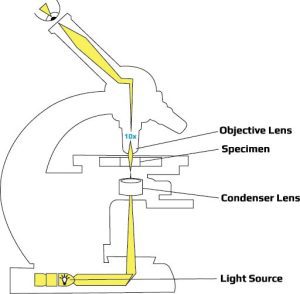
A light microscope is a type of microscope that uses visible light to illuminate a sample and produce a magnified image. It works by passing light through a lens system, which magnifies and focuses the image. Light microscopes can be used to observe a wide range of samples, including biological specimens such as cells and tissues, as well as non-biological materials like metals and crystals. There are several types of light microscopes, including brightfield, phase contrast, fluorescence, and confocal microscopes, each with their own unique features and applications. Light microscopy is an important tool in many fields of science, including biology, chemistry, physics, and materials science.
What is a compound microscope?
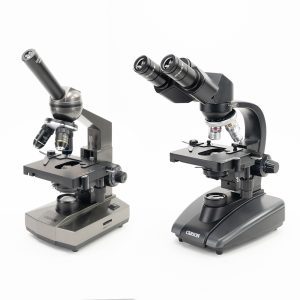
A compound microscope is a type of microscope that uses multiple lenses to magnify small objects. It is called a “compound” microscope because it uses two or more lenses to produce a magnified image of the specimen. Compound microscopes are commonly used in biology, medicine, and other scientific fields to observe and study small organisms, cells, and tissues. They are available in various designs and magnification levels, and can be equipped with additional features such as digital imaging capabilities, polarizers, and fluorescent filters.
Typically, a compound microscope uses two lenses: the objective lens and the eyepiece lens. The objective lens of a compound microscope is located at the bottom of the microscope and is used to collect light from the specimen. The eyepiece lens is located at the top of the microscope and is used to magnify the image formed by the objective lens. When light passes through the specimen and enters the objective lens, it is magnified and inverted. The image formed by the objective lens is then magnified again by the eyepiece lens, which produces an enlarged final image that can be seen by the observer.
What is a stereo microscope?
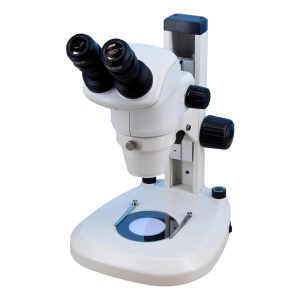
A stereo microscope, also known as a dissecting microscope, is a type of microscope that is designed for low magnification observation of three-dimensional objects. Unlike traditional compound microscopes, which have a single objective lens, stereo microscopes have two separate objective lenses that provide a 3D view of the specimen. Stereo microscopes are commonly used in fields of study such as biology, geology, and materials science for tasks such as dissection, quality control, and inspection of surfaces. They are particularly useful for examining objects that are too large, opaque, or three-dimensional to be observed under a traditional compound microscope.
Stereo microscopes are typically equipped with adjustable zoom magnification, allowing the user to view the specimen at different levels of detail. They also often have built-in light sources to provide bright, even light and illuminate the specimen. Additionally, stereo microscopes may include other advanced features such as a range of eyepieces, polarizing filters, and digital cameras for capturing images and videos of the specimen.
What is the difference between compound microscope and stereo microscope?
Compound microscopes and stereo microscopes are two different types of microscopes used in scientific research, education, and industry. The main differences between them are:
Magnification: Compound microscopes typically have higher magnification levels (up to 1000x) than stereo microscopes (up to 50x). This is because compound microscopes use multiple lenses to magnify the image, while a stereo microscope optical system use two separate optical paths to create a three-dimensional image of the sample.
Depth of field: Stereo microscopes have a larger depth of field than compound microscopes, which means that they can focus on a larger area of the sample at once. This is because stereo microscopes use two separate optical paths, which allows for a more three-dimensional view of the sample.
Image quality: Compound microscopes generally produce higher quality images than stereo microscopes. This is because they use multiple lenses to magnify the image, which reduces distortion and improves clarity.
Sample size: Stereo microscopes are typically used to view larger samples, such as insects, plants, or rocks, while compound microscopes are used to view smaller samples, such as cells or bacteria.
Overall, compound microscopes are more suitable for detailed examination of small samples, while stereo microscopes are better for viewing larger samples in 3D.
What is a biological microscope?

A biological microscope is an optical instrument used for observing small biological specimens such as cells, tissues, and microorganisms. It uses lenses to magnify the specimens and make them visible to the human eye.
All biological microscopes are compound microscopes but not all compound microscopes are biological microscopes. Biological microscopes are essential tools in fields such as biology, medicine, and research, and have played a critical role in advancing our understanding of the natural world.
What is a fluorescence microscope?

A fluorescence microscope is a type of optical microscope that utilizes fluorescence to create high-resolution images of biological samples. This type of microscope works by exciting fluorescent molecules within a sample with a specific wavelength of light, causing them to emit light at a longer wavelength, which is then detected by the microscope.
Fluorescence microscopes are powerful tools that allow researchers to observe and analyze the properties of biological samples and materials. These microscopes use fluorescent dyes or proteins to highlight specific structures or molecules within a sample, making them visible under the microscope. With their numerous applications in research and industry, fluorescence microscopes have become essential tools for scientists and engineers alike.
Fluorescence microscopes utilize a light source, such as a mercury or xenon arc lamp, to excite fluorescent molecules within a sample. The excitation light passes through a series of filters and mirrors to ensure that only the desired wavelength of light reaches the sample.
Once the fluorescent molecules within the sample are excited, they emit light at a longer wavelength, which is then collected and filtered by the microscope’s objective lens. The emitted light is then detected by a camera or photomultiplier tube, which produces an image of the sample. These microscopes utilize fluorescence to create high-resolution images of samples, making it possible to observe and analyze cellular processes in real-time.
What is a metallurgical microscope?
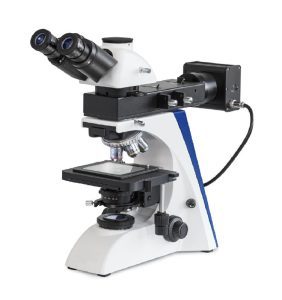
Which microscope is often used to view metal surfaces? A metallurgical microscope is a specialized type of microscope used to examine the microstructure of metals and alloys. It is equipped with features that allow for the observation of opaque samples in reflected light mode.
Metallurgical microscopes typically have a high level of magnification and a long working distance to accommodate larger samples. They also have specialized illumination systems that can be used to highlight specific features or structures of interest, such as grain boundaries, inclusions, or cracks.
These microscopes are commonly used in the fields of materials science, metallurgy, and engineering to study the properties and behavior of metals and alloys at the microscopic level. They are essential tools in the quality control and analysis of metals and alloys used in various industries, including automotive, aerospace, and construction.
What is an inverted microscope?
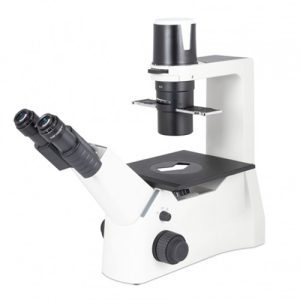
An inverted microscope is a type of optical microscope that has its light source and lenses positioned below the stage, pointing upwards. In contrast, a traditional upright microscope has its light source and lenses positioned above the stage, pointing downwards. With an inverted microscope, the sample is placed on the stage, which is positioned above the lenses, allowing the user to view the sample from below.
Inverted microscopes also offer other advantages, such as the ability to use longer working distances, allowing for the observation of thicker samples, and the ability to manipulate samples from below using micromanipulators or other tools. These features make inverted microscopes ideal for a wide range of applications in biological research, including cell culture, live cell imaging, and intracellular injection. This design is particularly useful for observing cells and other biological samples that are cultured or grown in a liquid medium, such as in tissue culture or in vitro fertilization.
How much is a microscope?
The cost of a microscope can vary greatly depending on the type of microscope and its intended use. Microscopes can range from ten dollars to a few hundred dollars to tens of thousands of dollars.
For example, a basic compound microscope for home or educational use can cost between $50 and $500. There are also small and portable, pocket microscopes that are quite powerful and cost less than $40. However, a research-grade compound microscope with advanced features such as fluorescence microscopy or confocal microscopy can cost tens of thousands of dollars.
Similarly, a basic stereo microscope used for inspecting small objects or materials may cost between $100 and $500, while a high-end stereo microscope with advanced features such as motorized zoom and high-resolution imaging can cost several thousand dollars.
Other factors that can affect the cost of a microscope include the quality of its lenses, the materials used in its construction, and the reputation of the manufacturer.
 OPTICS UNIVERSITY
OPTICS UNIVERSITY
0 comments on “What is a microscope?”